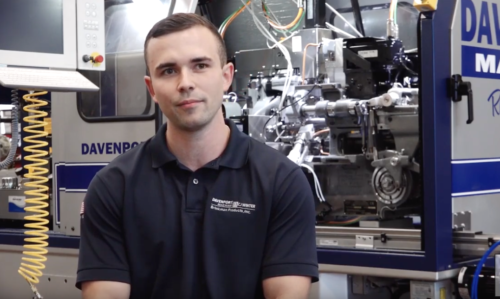Table of Contents
ToggleThe new Davenport Hybrid Machine is the future of Davenport multi-spindle machine tool technology. It incorporates the best of the mechanical versatility you have come to expect from Davenport, and leverages the power of an intuitive CNC interface to make operation and set-ups easier than ever.
These new capabilities answer to many of the internal demands of your workforce. The retirement of your most tenured operators can lead to a loss in tribal knowledge. Training a younger generation, whose skillsets are very different than those of generations past, can be challenging and time-consuming. The Davenport Hybrid brings real solutions to issues of workforce development.
 We recently sat down with John Henderson, Davenport Manufacturing Engineer, to talk about his experience with the new Davenport Hybrid Machine. John is a recent (2018) graduate from Rochester Institute of Technology with a Bachelor’s in Mechanical Engineering. At the time of this publication, John has been working with Davenport Machine for a little under two years.
We recently sat down with John Henderson, Davenport Manufacturing Engineer, to talk about his experience with the new Davenport Hybrid Machine. John is a recent (2018) graduate from Rochester Institute of Technology with a Bachelor’s in Mechanical Engineering. At the time of this publication, John has been working with Davenport Machine for a little under two years.
Prior to his hire at Davenport Machine, John had little to no experience in an action manufacturing environment.
Can you talk a little bit about your journey from engineering student to Davenport Manufacturing Engineer?
When I first joined Davenport, we were just beginning to make parts on the Hybrid concept (prototype) machine. It became my responsibility to learn how the machine operates. I read a machining manual on basic G-code which all of your typical industry standard CNC machines follow, and shadowed one of our more experienced manufacturing engineers. It was through that hands-on experience that I picked up on the operation of the machine.
The Hybrid Machine has been designed from the ground up to be easier to program, setup and operate. Can you talk about your training and use of the machine?
From Day One the Hybrid was designed with the end user in mind. Davenport machines historically had to overcome an impression that the machines were challenging to set up and run. All of our design criteria for the machine involved trying to mitigate that notion about Davenport.
There are several features on the machine that make it, well, not the legacy Davenport machine. All of our tooling on the machine is quick-change tooling, which can be set up and pre-set on the bench while you’re running the machine. That way, when it comes time to swap out tools, all that’s required is a couple bolts and you’re back up and running!
In my opinion, one of the better features of the machine is your ability to comp diameters in your CNC slides on the fly, without shutting down the machine. Say you’re running a part and your tolerance is starting to creep up. With the press of a button you can offset an update so that the next part that’s presented to that tool will have that comp reflected in it. This allows you to can keep your parts in tolerance part after part after part without stopping the machine.
Were you involved at all in the programming of the machine?
Yes, we get to wear a lot of hats here. I had my hands on everything from design, set up, customer part runoffs, and programming the CNC axis.
What is the easiest part about operating the Hybrid Machine?
Unlike the legacy Davenport Machine, the Hybrid doesn’t have clutches and brakes, where you have to reach into a machine and pull a lever to operate it. Our Hybrid is outfitted with a 15-inch touch screen, and the operator has all the information necessary to run the machine right in front of him/her. You can access all of the functionality of the machine on one page, while the machine is active and running parts. The user interface is super easy to navigate, and I think that makes the machine that much easier to use.
What would you say to someone who has little to no manufacturing experience, who needs to train on the Hybrid Machine?
First and foremost, gone is the need for years of mastering the intricacies and “art” of the Model B. The Davenport name is on the machine, which means the highest quality engineered and produced machine, but it’s not your traditional Model B. It truly is a CNC machine that the next generation can learn to operate quickly and easily. That was the whole purpose of releasing this product. Don’t be intimidated by the history: it’s a lot simpler now.
What kinds of things are you now capable of performing on the machine?
In previous generations, all of your side working axis were controlled by cams. In order to present a tool to a workpiece, you had to have a cam made which would drive your tool in and out. That takes time, and downtime means lost potential revenue! First, you have to call us and have a cam made, sent to your facility, and installed.
With CNC control, you can create a new cam in a matter of minutes with the click of a button, bypassing the four or five days it previously took with the legacy machines. That’s a huge advantage.
To hear more from John and a couple of other engineers at our shop, check out our latest video.
